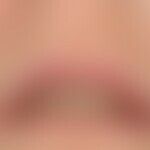Synonym(s)
DefinitionThis section has been translated automatically.
The skin aging process is essentially composed of 2 processes:
- Biological or endogenous ageing (ageing) also intrinsic skin ageing
- environmental ageing or exogenous ageing (especially light ageing) also extrinsic skin ageing
EtiopathogenesisThis section has been translated automatically.
Polyetiologic endogenously and exogenously induced process. Discussed are:
- Metabolic changes (such as the irreversible accumulation of Advanced Glycation Endproducts - AGEs). AGEs are bioactive molecules that may serve as a strong and independent predictor of atherosclerosis and cardiovascular mortality in diabetic and hemodialysis patients.
- UV-induced inflammatory reactions, such as those initiated via the activated acrylic hydrocarbon receptor.
- Genetic alterations (dysregulation of the insulin and STAT3 signaling pathway; upregulation of proaptotic genes, alterations of cytoskeletal genes such as keratin 2A, 6A, and 16A).
- Damage caused by free radicals (especially membrane damage due to lipid peroxidation). Origin of free radicals (see oxidative stress below): endogenous from mitochondrial respiration, enzymatic reactions (oxidases), arachidonic acid metabolism, phagocytosis processes or exogenous from food, drugs, environmental toxins, UV light.
- Alteration of the Wnt signaling pathway (regulates various processes in embryonic development). processes in embryonic development and can lead to tumorigenesis) is suppressed at both RNA and protein level.
- Influences due to reduced hormone levels.
- Age-related atrophy of blood vessels leads to sclerosis of the dermis, which increases the hemidesmosome fragility of interfollicular stem cells (IFESCs). Age-related IFESCs dysregulation is associated with prolonged calcium influx caused by the mechanoresponsive ion channel Piezo1 (Ichijo et al. 2022).
- An anti-angiogenic secretory molecule, pentraxin 3 , plays an essential role in age-related sclerosis of the skin (Ichijo et al. 2022).
Studies on best. Progeria syndromes show that certain important biological processes such as DNA replication, recombination, repair and transcription - as well as mitochondrial functions, cell cycle and apoptosis - play an important role in skin ageing.
Furthermore, the skin ageing process is negatively influenced by infrared radiation, nicotine abuse or environmental pollution (e.g. fine dust pollution).
You might also be interested in
LocalizationThis section has been translated automatically.
Entire skin organ with predilection in areas exposed to light (factor light ageing).
ClinicThis section has been translated automatically.
General: Decrease in turgor and blood circulation, reduced sebum and sweat gland production, tendency to exsiccation, reduced subcutaneous adipose tissue, thinned dermis, pigment shifts ( lentigo solaris, hypomelanosis guttata idiopathica), benign and malignant neoplasms ( verrucae seborrhoicae, telangiectasias, basal cell carcinomas, spinocellular carcinomas), increased capillary fragility and vulnerability ( purpura senilis, pseudocicatrices stellaires), elastosis in light-exposed areas ( cutis rhomboidalis nuchae, M. Favre-Racouchot).
Aged skin: smooth, hardly any skin lesions, accentuation of mimic wrinkles (water loss), slight loss of elasticity.
Light-aged skin: leathery aspect, pigment shifts, disseminated formation of deep wrinkles, considerable loss of elasticity.
HistologyThis section has been translated automatically.
| Frequent histological manifestations of skin aging: | ||
| Dermal structure | Aged skin | Light aged skin |
| Epidermis | diluted, no atypias | acanthosis, cell atypia |
| Papillary dermis | thin boundary zone | thickened border zone, actin. Elastosis |
| Reticular dermis | diluted, fewer fibroblasts with low activity, fewer mast cells | thickened, elastosis, increased fibroblasts, with increased activity, mast cell proliferation |
| Collagen fibers | reduced, increase in cross-linking with compression, disordered bundles | degenerative changes and reduction |
| Elastic fibres | normal to slightly reduced | considerable tissue proliferation, degeneration |
| Dermal vessels | moderately diminished | considerably reduced, telangiectasia |
DiagnosisThis section has been translated automatically.
TherapyThis section has been translated automatically.
- Combinations of various therapies are possible and useful.
- Prophylaxis through antioxidants systemically (vitamin A, beta-carotene, vitamin E, vitamin C) or locally, skin care, sun protection, avoidance of nicotine and excessive UV exposure.
- Tretinoin and isotretinoin creams, chemical peeling with peeling substances such as salicylic acid, trichloroacetic acid or fruit acids (AHS).
Operative therapieThis section has been translated automatically.
LiteratureThis section has been translated automatically.
- Ichijo R et al. (2022) Vasculature atrophy causes a stiffened microenvironment that augments epidermal stem cell differentiation in aged skin. Nat Aging 2:592-600.
- Kusserow A et al. (2005) Unexpected complexity of the Wnt gene family in a sea anemone. Nature 433:156-160.
- Makrantonaki E (2015) Skin aging. Dermatologist 66: 730-737
- Si Tao et al. (2015) Wnt activity and basal niche position sensitize intestinal stem and progenitor cells to DNA damage. EMBO J doi: 10.15252/embj.201490700.
- Spanjer AI et al. (2016): TGF-β-induced profibrotic signaling is regulated in part by the WNT receptor Frizzled-8. FASEB Journal doi: 10.1096/fj.201500129
- Uribarri J et al.(2007): Circulating glycotoxins and dietary advanced glycation endproducts: two links to inflammatory response, oxidative stress, and aging. J Gerontol A Biol Sci Med Sci 62: 427-433.
- Vierkötter A et al. (2010) Airborne particle exposure and extrinsic skin aging. J Invest Dermatol 130:2719-2726.
Incoming links (5)
Arylhydrocarbon receptor; Elastic fibres; Glycation; Matrix metalloproteinases; Uv rays;Outgoing links (25)
Acrylic hydrocarbon receptor; Ages; Antioxidants; Basal cell carcinoma (overview); Chemical peeling; Cryosurgery; Cutis rhomboidalis nuchae; Dermabrasion; Elastoidosis cutanea nodularis et cystica; Extrinsic skin aging; ... Show allDisclaimer
Please ask your physician for a reliable diagnosis. This website is only meant as a reference.



















